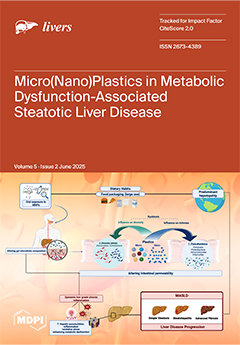Background and aims: The CC5, CXC3, and CC2 chemokines (CK) are known to play a role in the pathogenesis of autoimmune hepatitis (AIH). However, no data are available on their potential utility as markers of disease progression or response to treatment. Material and
[...] Read more.
Background and aims: The CC5, CXC3, and CC2 chemokines (CK) are known to play a role in the pathogenesis of autoimmune hepatitis (AIH). However, no data are available on their potential utility as markers of disease progression or response to treatment. Material and methods: We analyzed their role as markers of remission in a population of patients with AIH. We retrospectively investigated the kinetics of RANTES (CCL5), IP-10 (CXCL10), and MCP-1 (CCL2) in 48 patients with AIH at the time of treatment initiation and also in 32 at biochemical, clinical and histological remission. Forty-nine healthy donors (HDs) served as controls. Results: At baseline, IP-10 and MCP-1 levels were higher in AIH patients than in HDs (261 vs. 101 pg/mL and 689 vs. 330 pg/mL,
p < 0.01), and RANTES levels showed no differences. Correlations were observed between RANTES and IgG concentrations (r = 0.36
p = 0.04) and between IP-10 and Ishak’s grade (r = 0.52
p = 0.02). At remission, in 32 patients, while IP-10 and MCP-1 values showed a significant decrease from baseline reaching HD levels (261 vs. 106 pg/mL and 689 vs. 387 pg/mL,
p < 0.01), RANTES did not. However, two kinetics patterns emerged, with 20 patients showing lower and 12 higher baseline RANTES values compared to HDs (29,450 pg/mL and 70,960 pg/mL vs. 52,010 pg/mL,
p < 0.01). The former required longer treatment to reach remission and had higher Ishak’s grades than the latter (
p < 0.01). Conclusions: RANTES, IP-10, and MCP-1 may help in predicting response to treatment and stable remission and in supporting the decision if and when to discontinue immune suppressive therapy.
Full article





